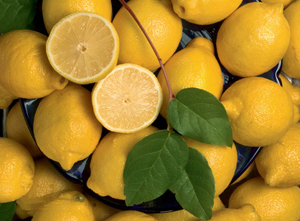
The natural environment which is typical of the Sorrento area is for sure the lemon-grove.
The lemon of Sorrento is the “Oval of Sorrento” cultivar, known affectionately as “Femminello”. This fruit medium to large-sized fruit weighing at least 85 g, is elliptical in shape, has a strong scent and is very juicy. The yellow part of the peel is rich in essential oils and the juice from the fruit has an instantly recognizable combination of citrus acid and sugar. In 2000, the “Femminello” received Protected Geographical Indication (PGI) recognition under European Union regulations. This protects the cultivar and defines the geographical area where the lemon can be grown as the Sorrento peninsula and the Isle of Capri. The PGI stamp also requires that cultivation is carried out in a specific (and organic) way, under the “pagliarelle”, which are like “mats” that protect against the saltness in the air, drops in temperature and delay ripening (a defining characteristic of this lemon). The cultivar is remontant: in October, the first fruit (“primofiore”) has the juiciest lemons; in March, the light yellow “bianchetti” ripen; and in June, the “verdelli” or green lemons are ready.
Due to their sun-filled beauty, citrus fruit where first used as decorative plants and were even celebrated in rawdija (a genre of Arabian poetry). It was also the Arabs who discovered the healing properties of the essential oils and juices extracted from the bark, flowers and fruit of the laymun (lemon), narang (sour orange), ‘utrug (citron) and so on.
The distillation of al-kuhul (alcohol) by means of the al-inbiq (alembic) was also a part of Arabian pharmacopoeia. Adding aromatic herbs to alcohol produced al-iksir (elixirs), which, for centuries, were vital for doctors, chemists and then, in monasteries. Some time in the 15th or 16th centuries, monks started to combine flavoured alcohol with sweet syrups, thus giving birth to the era of liqueurs and rosolios (sweet liqueurs). It will always be a mistery whether it was monks or a clever housewife who first “macerated” lemon peel in alcohol and sugar syrup, but the result, “limoncello” or “limonillo” in the dialect of Sorrento, is now a typical local product.